The NVIDIA GeForce GTX 780 Ti Review
by Ryan Smith on November 7, 2013 9:01 AM ESTHands On With NVIDIA's Shadowplay
Though it’s technically not part of the GeForce GTX 780 Ti launch, before diving into our typical collection of benchmarks we wanted to spend a bit of time looking at NVIDIA’s recently released Shadowplay utility.
Shadowplay was coincidentally enough first announced back at the launch of the GTX 780. Its designed purpose was to offer advanced game recording capabilities beyond what traditional tools like FRAPS could offer by leveraging NVIDIA image capture and video encode hardware. In doing so, Shadowplay would be able to offer similar capabilities with much less overhead, all the while also being able to utilize the NVENC hardware H.264 encoder to encode to space efficient H.264 rather than the bulky uncompressed formats traditional tools offer.
With Shadowplay and NVIDIA’s SHIELD streaming capabilities sharing so much of the underlying technology, the original plan was to launch Shadowplay in beta form shortly after SHIELD launched, however Shadowplay ended up being delayed, ultimately not getting its beta release until last week (October 28th). NVIDIA has never offered a full accounting for the delay, but one of the most significant reasons was because they were unsatisfied with their original video container choice, M2TS. M2TS containers, though industry standard and well suited for this use, have limited compatibility, with Windows Media Player in particular being a thorn in NVIDIA’s side. As such NVIDIA held back Shadowplay in order to convert it over to using MP4 containers, which have a very high compatibility rate at the cost of requiring some additional work on NVIDIA’s part.
In any case with the container issue resolved Shadowplay is finally out in beta, giving us our first chance to try out NVIDIA’s game recording utility. To that end while clearly still a beta and in need of further polishing and some feature refinements, at its most basic level we’ve come away impressed with Shadowplay, with NVIDIA having delivered on all of their earlier core promises for the utility
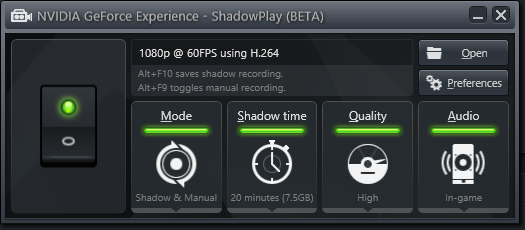
With regards to functionality, all of Shadowplay’s basic functionality is in. The utility offers two recording modes: a manual mode and a shadow mode, the former being self-explanatory while the latter being an always-active rolling buffer of up to 20 minutes that allows saving the buffer after the fact in a DVR-like fashion. Saving the shadow buffer causes the entirety of the buffer to be saved and a new buffer started, while manual mode can be started and stopped as desired.
| Shadowplay Average Bitrates | |||
| High Quality | 52Mbps | ||
| Medium Quality |
23Mbps
|
||
| Low Quality |
16Mbps
|
||
Next to being able to control the size of the shadow buffer, Shadowplay’s other piece of significant flexibility comes through the ability to set the quality (and therefore file size) of the recordings Shadowplay generates. Since Shadowplay uses lossy H.264 the recording bitrates will scale with the quality, with Shadowplay offering 3 quality levels: high (52Mbps), medium (23Mbps), and low (16Mbps). Choosing between the quality levels will depend on the quality needed and what the recording is intended for, due to the large difference in quality and size. High quality is as close as Shadowplay gets to transparent compression, and with its large file sizes is best suited for further processing/transcoding. Otherwise Medium and Low are low enough bitrates that they’re reasonably suitable for distribution as-is, however there is a distinct quality tradeoff in using these modes.
Moving on, at this moment while Shadowplay offers a range of quality settings for recording it only offers a single resolution and framerate: 1080p at 60fps. Neither the frame rate nor the resolution is currently adjustable, so whenever you record and despite the resolution you record from, it will be resized to 1920x1080 and recorded at 60fps. This unfortunately is an aspect-ratio unaware resize too, so even non-16:9 resolutions such as 1920x1200 or 2560x1600 will be resized to 1080p. Consequently at this time this is really the only weak point for Shadowplay; while the NVENC encoder undoubtedly presents some limitations, the inability to record at just a lower resolution or in an aspect ratio compliant manner is something we’d like to see NVIDIA expand upon in the final version of the utility.
Finally, let’s talk about performance. One of Shadowplay’s promises was that the overhead from recording would be very low – after all, it needs to be low enough to make always-on shadow mode viable – and this is another area where the product lives up to NVIDIA’s claims. To be sure there’s still some performance degradation from enabling Shadowplay, about 5% by our numbers, but this is small enough that it should be tolerable. Furthermore Shadowplay doesn’t require capping the framerate like FRAPS does, so it’s possible to use Shadowplay and still maintain framerates over 60fps. Though as to be expected, this will introduce some frame skipping in the captured video, since Shadowplay will have to skip some frames to keep within its framerate limitations.
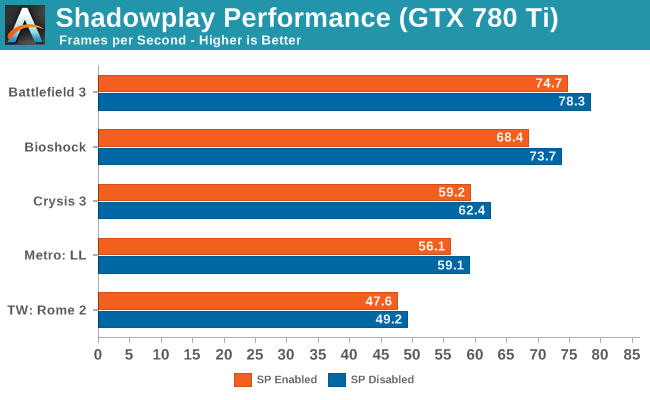
On a related note, we did some digging for a technical answer for why Shadowplay performs as well as it does, and found our answer in an excellent summary of Shadowplay by Alexey Nicolaychuk, the author of RivaTuner and its derivatives (MSI Afterburner and EVGA Precision). As it turns out, although the NVENC video encoder plays a part in that – compressing the resulting video and making the resulting stream much easier to send back to the host and store – that’s only part of the story. The rest of Shadowplay’s low overhead comes from the fact that NVIDIA also has specific hardware and API support for the fast capture of frames built into Kepler GPUs. This functionality was originally intended to facilitate GRID and game streaming, which can also be utilized for game recording (after all, what is game recording but game streaming to a file instead of another client?).
This functionality is exposed as Frame Buffer Capture (NVFBC) and Inband Frame Readback (NVIFR). NVFBC allows Shadowplay to pull finished frames straight out of the frame buffer directly at a low level, as opposed to having to traverse the graphics APIs at a high level. Meanwhile NVIFR does have operate at a slightly higher level to inject itself into the graphics API, but in doing so it gains the flexibility to capture images from render targets as opposed to just frame buffers. Based on what we’re seeing we believe that NVIDIA is using NVFBC for Shadowplay, which would be the lowest overhead option while also explaining why Shadowplay can only capture full screen games and not windowed mode games, as frame buffer capturing is only viable when a game has exclusive control over the frame buffer.
Wrapping things up, it’s clear that NVIDIA still has some polishing they can apply to Shadowplay, and while they aren’t talking about the final release this soon, as a point of reference it took about 4 months for NVIDIA’s SHIELD game streaming component to go from beta to a formal, finished release. In the interim however it’s already in a very usable state, and it should be worth keeping an eye on in the future to see what else NVIDIA does to further improve the utility.
The Test
The press drivers for the launch of the GTX 780 Ti are release 331.70, which other than formally adding support for the new card is otherwise identical to the standing 331.65 drivers.
Meanwhile on a housekeeping note, we want to quickly point out that we’ll be deviating a bit from our normal protocol and including the 290X results for both normal (quiet) and uber modes. Typically we’d only include results from the default mode in articles such as these, but since we need to cover SLI/Crossfire performance and since we didn’t have 290X CF quiet mode results for our initial 290X review, we’re throwing in both so that we can compare the GTX 780 Ti to the 290X CF without being inconsistent by suddenly switching to the lower performance quiet mode numbers. Though with that said, for the purposes of our evaluation we will be focusing almost entirely on the quiet mode numbers, given the vast difference in both performance and noise that comes from using it.
| CPU: | Intel Core i7-4960X @ 4.2GHz |
| Motherboard: | ASRock Fatal1ty X79 Professional |
| Power Supply: | Corsair AX1200i |
| Hard Disk: | Samsung SSD 840 EVO (750GB) |
| Memory: | G.Skill RipjawZ DDR3-1866 4 x 8GB (9-10-9-26) |
| Case: | NZXT Phantom 630 Windowed Edition |
| Monitor: | Asus PQ321 |
| Video Cards: |
AMD Radeon R9 290X AMD Radeon R9 290 XFX Radeon R9 280X Double Dissipation AMD Radeon HD 7990 AMD Radeon HD 7970 NVIDIA GeForce GTX Titan NVIDIA GeForce GTX 780 Ti NVIDIA GeForce GTX 780 NVIDIA GeForce GTX 770 |
| Video Drivers: |
NVIDIA Release 331.58 WHQL NVIDIA Release 331.70 Beta AMD Catalyst 13.11 Beta v1 AMD Catalyst 13.11 Beta v5 AMD Catalyst 13.11 Beta v8 |
| OS: | Windows 8.1 Pro |


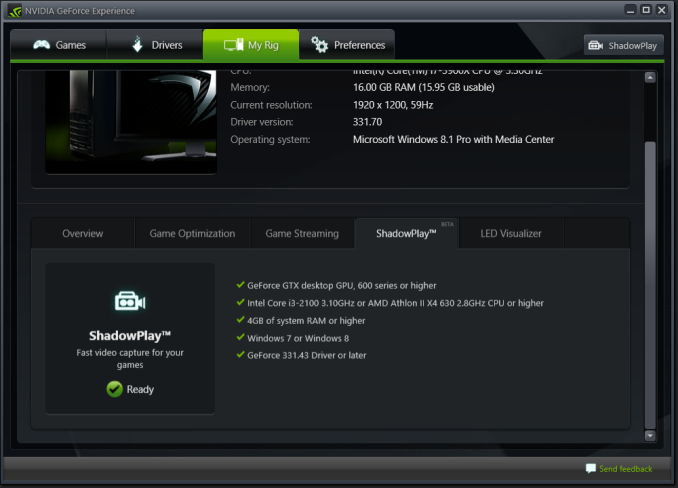
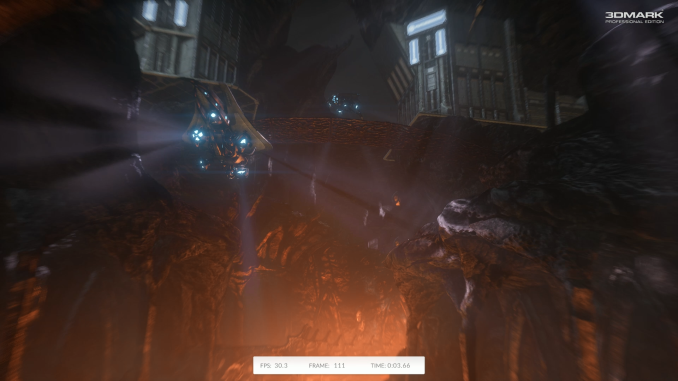

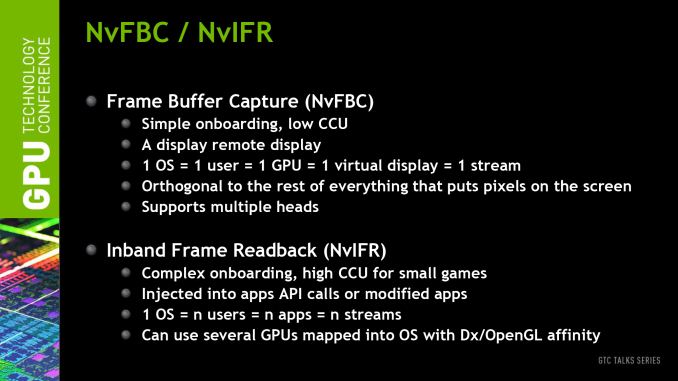














302 Comments
View All Comments
NewCardNeeded - Thursday, November 7, 2013 - link
Even the R9 280X crossfire beats the GTX 780 Ti in SLI in several cases !!!!!!!! Note that I do mean the 280, it's not a typo. The 290X Crossfire *SLAUGHTERS* the 780 Ti in SLI AND it's a fraction of the price.austinsguitar - Thursday, November 7, 2013 - link
okay okay...lets tell this guy about what happens after a new nvidia graphics card comes out shall we...first 2 weeks a card comes out (ALWAYS UN OPTIMIZED FOR SLI) 2 weeks later (ABSOLUTE SCALING WITH THE NEXT AVAILABLE DRIVER) happens every time dude. That little guy will be better in two weeks, just trust meNewCardNeeded - Thursday, November 7, 2013 - link
I'm not so sure this time. Nvidia have held back the 780 Ti for months until AMD released their new cards. They've had plenty of time to optimize for SLI. Expect small gains yes, but nothing more.Let's see what happens when mantle comes out...
austinsguitar - Thursday, November 7, 2013 - link
Temperature, power (wattage), noise....This beats the 290x bad....Think about this....95 degrees and the ungodly noise coming from the 290x is ABSOLUTELY "UN"ACCEPTABLE... The card is cheap yes, but after 2 years of game playing your energy bill will determine that factor. I do realize that amd's drivers are getting better, but come on people....mantle?
NewCardNeeded - Thursday, November 7, 2013 - link
Have you never heard of a "third party cooler"?Coming this way soon !
NewCardNeeded - Thursday, November 7, 2013 - link
Read the article again without your green tinted glasses on!Full load on Crysis 3:
Power (W):
780 Ti = 372
290X = 375
Does it really beat the 290X bad?
austinsguitar - Thursday, November 7, 2013 - link
oh im sorry i was speaking about crossfire and sli configurations when putting into account the power draw... and everyone knows that when nvidia plays its games at 60 it clocks things lower, and power draw is very impressive...odds are these cards will never see below 60 for a while now, and nvidia's power draw at medium loads are phenomenal.Kutark - Thursday, November 7, 2013 - link
Jesus Christ, i've been reading the comments. The AMD fanbois are starting to get worse than Biodrones were during the release of TORtanic. Granted there is some definite Nvidia fanboism going on but the reality is this. Nvidia is on a 9 month old architecture and is able to put out a card that beats AMD's brand new architecture's top dawg by roughly 10%, running at a significantly lower temperature, and significantly quieter.Does that justify a $200 price gap? Well thats up to the consumer to decide. But to try to suggest this is a "Tie" or anything other than Nvidia reclaiming the fastest single card crown is just being ridiculous.
I just find it hilarious some of these AMD people sitting here spouting off these very specific scenarios where the AMD card comes out on top and acts like that means anything. Ok, so crossfire 290x (only a thousand dollars!) beats sli 780ti's in several cases, whoopety do. This will affect all of the 1/10th of 1% of people who will pay that kind of money for a graphical solution on their gaming rigs.
The other thing is, Nvidia's architecture is 9 months old for shits sake. You dont think they will have something else out in a few months thats going just crap all over AMD's new
Kutark - Thursday, November 7, 2013 - link
Gah, stupid IE9 (im on a computer i can't install a good browser on). Anyways, i was just saying, Nvidia will likely release something early to mid 2014 which will probably blow any current gen cards out of the water and then where is AMD? Same spot they've been in?I'm glad AMD released the 290x, it is overall a HUGE step forward for them and im glad nvidia has some real competition. That is only a good thing for the consumer. But overblowing this 290x as something it isnt is not doing any favors. We need to stop blowing smoke up AMD's ass so they actually keep pushing themselves and come out with a proper Nvidia smasher, and then nvidia will be in a position that they cant keep charging 400-800 dollars for cards that should be 250-400 dollars.
UpSpin - Friday, November 8, 2013 - link
I don't get your comment and I'm no GPU fanboy at all (even though I only bought NVidia GPUs in the past), because I barely game high end games and find such high prices (both AMD and NVidia) for a GPU ridiculous. But I'm interested in tech and consider buying a mid-tie GPU because my Nvidia GTX 560 TI starts acting strange.What matters is what NVIDIA or AMD sells now and what it costs now. It's a fact, that the 290X beats in half of the benchmarks the 780 Ti. The other half the 780 Ti wins. It's a fact, that the power draw between both single cards is identical. And it's a fact that the newly released 780 Ti is $150 more expensive than the newly released 290X.
Of course is the 290X too loud, but that's not a issue of the GPU (same power draw), more of the cooler, which should be fixed with a third party cooler implemented by ASUS, ... The NVidia reference coolers were always superb (that's why I own a reference EVGA 560 Ti, because it was really silent compared to the similar priced alternatives).
We live here and now and we can only buy the current stuff. So I don't care if Nvidia might release in the near or far future an even better card (at the time AMD might release a new card, too). And if you want to buy a GPU now, the Nvidia is, regarding the price, a complete rip off compared to the AMD.
As an excuse for the 'poor' performance of the Nvidia card you said, it's 9 month technology. So let me get this straight:
NVidia sells you 9 month old technology for $150 more than AMD asks you for the latest bleeding edge technolgy they can offer? And you defend this? Are you serious? Nvidia sold the Titan for even more during the last months. So be damn happy that AMD released such a great card at such a low price point, else you would get ripped off by NVidia the following months, too.